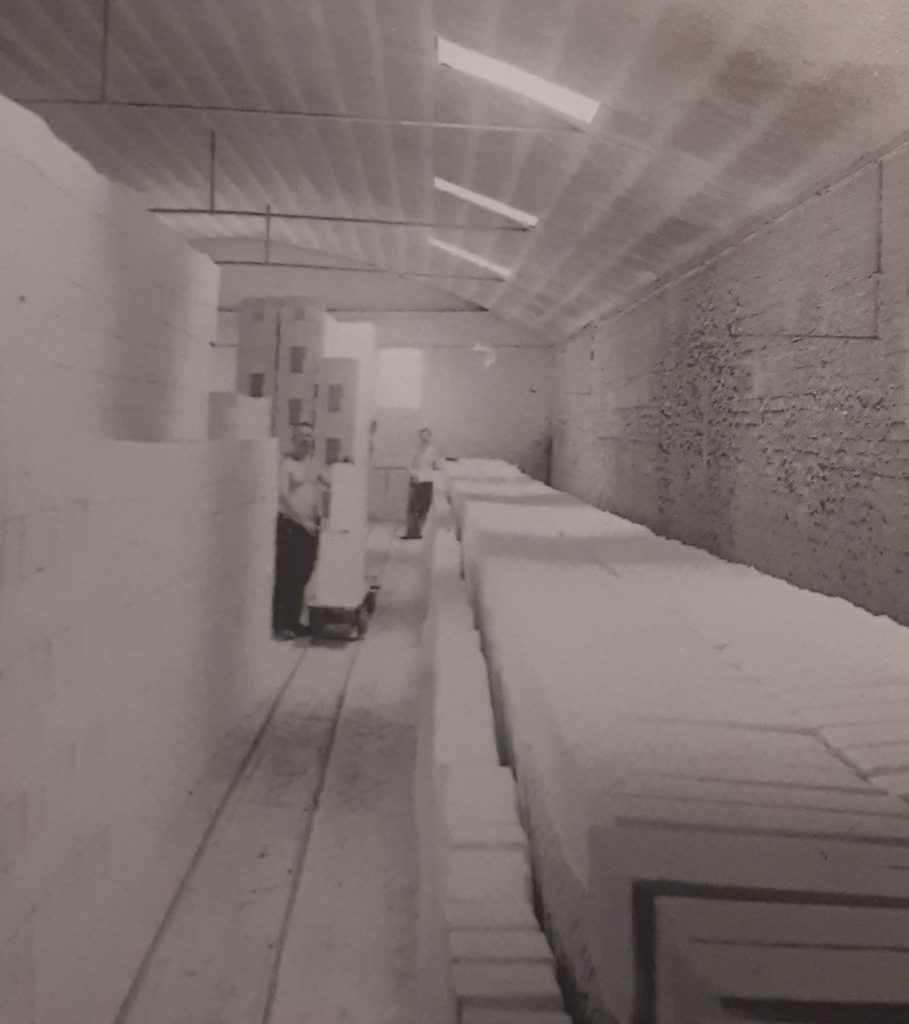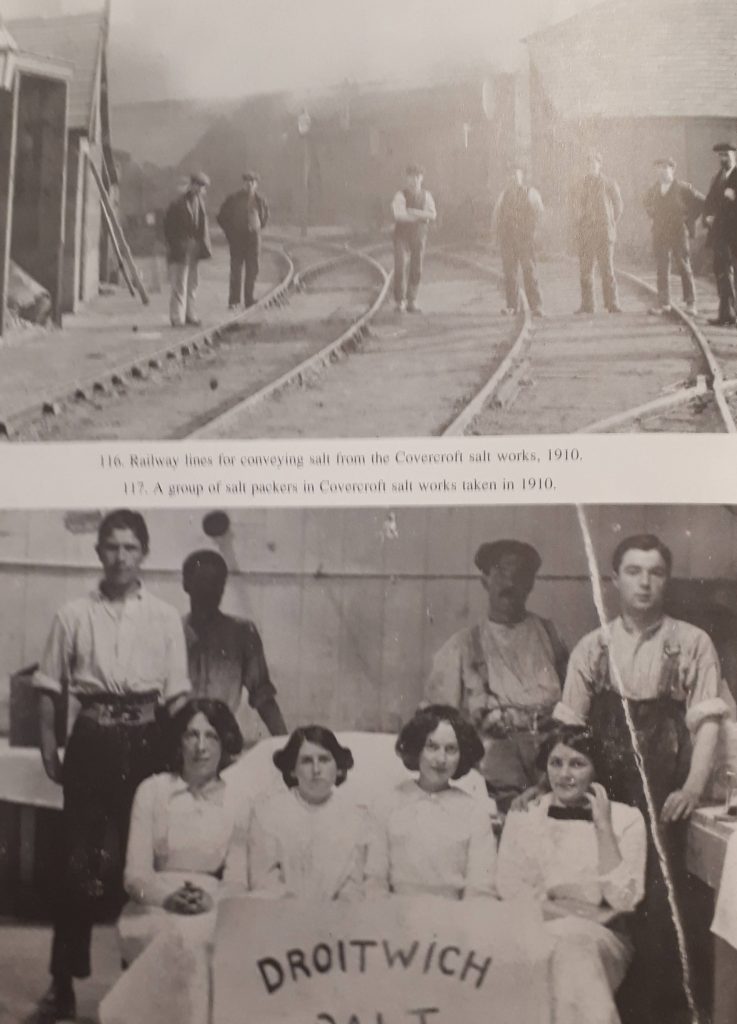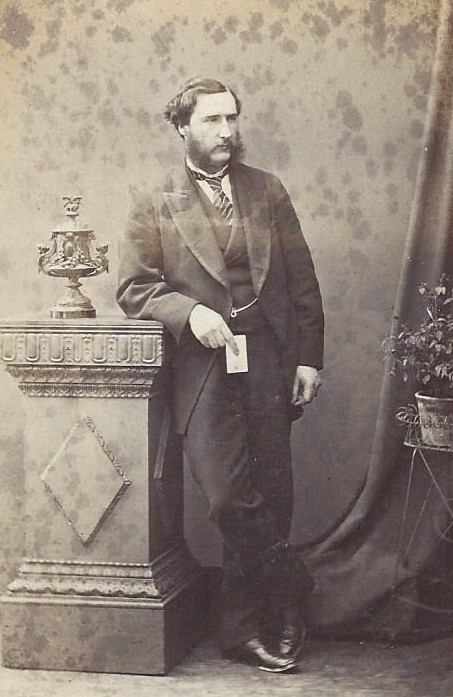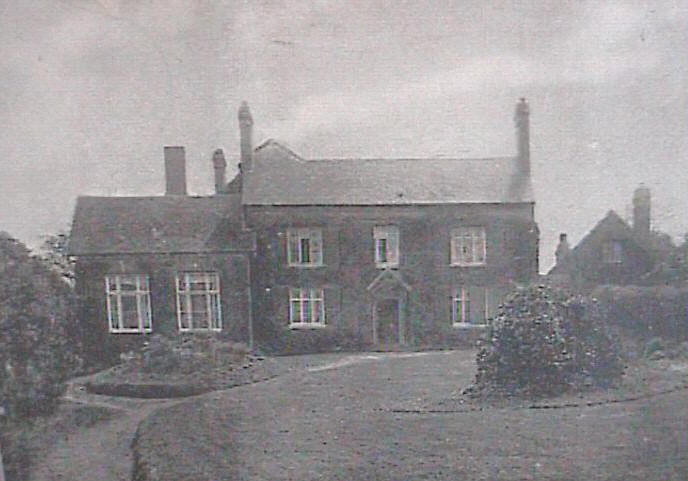John Howard, Percy, Frederic, JOHN HENRY, Benjamin, Thomas, Anthony, Henry
The caption on the portrait reads ‘This portrait of John Henry Bradley Esq. several times Mayor of Droitwich and for many years Manager of the Salt Manufactories there, was painted at the request of his friends especially those amongst the working classes and presented to Mrs Bradley as a memorial of the great respect and esteem universally entertained towards her husband. 1869.’
John was a successful businessman and Saltworks Owner. John Henry was born in Birmingham 1807 and was living in Rusholme, Manchester around 1829 when he married Susannah Lovatt by licence in the Parish of Bowden, Cheshire. We don`t know if he was involved in the salt industry at this time. Their two eldest children, Elizabeth and Benjamin (the latter died in infancy) were born at Stoke Prior, Worcs. Jane, Benjamin(2), Mary Emma, Samuel and Frederic were born in Droitwich, John (between Benjamin and Mary Emma) was born in Claines and Charles the youngest in Salwerpe. In 1841 they were living in Salwerpe with Elizabeth age 10, Jane 6, Benjamin 5, John 4, Mary 3 and Samuel 2. In 1851 they had moved to St.Andrew St. in Droitwich along with Frederic and Charles. In 1861 they were living at the Oaklands, Witton.
John Henry became a wealthy man through the Salt industry. The above portrait, owned by David Bradley, grandson of Neville, has kindly been photographed for me by David. The portrait was presented to John Henry by his employees on his retirement. John Henry became a manager/owner of Chapel Bridge Salt Works and then owned Bradley Salt Works in Hanbury Road, and Droitwich Salt Works, Droitwich. He eventually built and lived in the Oaklands, a large and impressive house which was at a later date used as a nursing/convalescent home and then a children`s home in 1920. It has now been pulled down and is part of a housing estate. He became a prominent member of the community and was Mayor of Droitwich in 1848 – 1850, 1853, 1855, 1858 and 1859. His eldest son John took over the Salt interests, and it seems that John Henry then arranged for Samuel and Frederic to start up in the Iron Foundry business, Samuel in Blakedown and Frederic in Kidderminster. He died in 1880 while living at The Oaklands (Will). Susannah died in 1886.

These photos above and those below of the Covercroft salt works were taken from the book Droitwich A Pictorial History by Lyn Blewitt and Bob Field
Daughter Elizabeth died age 29 in 1860.
The first Benjamin as mentioned above, died in infancy.
Jane died age 10 in 1845.
The second Benjamin died in 1852 age 15.
John was born in 1836. In 1851, according to the census for that time, he was staying with his Uncle Benjamin in Rusholme, Manchester. He went on to become an accountant and took over the Saltworks business from his father. He too became Mayor of Droitwich for a number of years in 1875, 1876, 1882, 1883, 1904, and 1905. He was a member of the town council and served continuously for 46 years from 1867. He became an Alderman in February 1884. In 1900 he became a county magistrate. He managed the design and erection of the Droitwich Covercroft Works. He became a member of the first County Council in 1889. He was also on the management committee of the St Johns Brine Baths, a Coventry Almshouse Trustee, Vice President of the Primrose League and ensign of the local company of the Worcestershire Rifles. He married Kate Nash and had a daughter Kate (remained a spinster) and she died 14th September 1963. Probate granted at £32,000. Also three sons. Benjamin George is living at home with his parents and sister in 1911. He died 8th March 1929, Tallow Hill, Worcester. Effects £611 10s 4d. Herbert Frederick – I think he married Kate Patten? Grove Smith. Grove married Leila who was born in Canterbury, New Zealand. Did he travel there and the marriage took place in New Zealand? No record here. In 1911 Grove is a poultry farmer in Blackthorn, Oxfordshire. with Leila his wife of 4 years. In 1939 he and Leila are living in Devonshire at Windycroft, Green Lane, Islington, Bovey Tracey He died 22 March 1942 and Leila in 1965. John lived at the Oaklands after his father died. Wife Kate died in 1911 (Will). John died in 1916 (Will). Worcester.

.
John`s sister Mary Emma died in 1852 age 14.
Samuel, (born 1839), a younger brother of John, married his first cousin Sarah Oldham from Dublin and they married in Ireland 1868. There are further Bradley/Oldham connections in other generations which prove interesting – the first that we know of is Mary Anne Bradley (this Samuel`s aunt) marrying Thomas Wilson Oldham. Also Benjamin William Smith Bradley`s daughter Lucy married James Oldham. Samuel`s father John Henry acquired the Springbrook Forge in Blakedown for Samuel in 1856.
Samuel Bradley – brother to great grandfather Frederic
Samuel married Sarah Ann Oldham July 16 1868 in Monkstown, Dublin, Ireland. They had 7 children.
John Henry born and died 1869.
Twin girls Ellen and Kathleen born 1870 in Stoke Prior. Kathleen married twice, first to William Frederick Preedy in 1907 (no children in 1911 census in Ealing) and second to Tom Grazebrook in 1925.
Mary Florence born 1872. 1911 census she is age 39 and single with her sister Kathleen Preedy in Ealing.
William Henry Bradley born 1873 married Maud Mary Figgis 1902. In 1911 He and Maud are living in Melton in Suffolk with their 2 sons Howard Neville age 7 and Samuel Clive 5. William is an Agricultural Implement Maker and an employer. In 1939 he and Maud are living in Horsham at Four Firs.
Leonard born 1874 married Stella Chambers. Two children Monica and Naomi. Monica married Edward Brazier and they had a son Jonathon. Naomi married John Sandys and they had two childen Frances and Lizzie. Leonard went into the church and was curate at St Stephens, Redditch 1906-12, then to Holy Trinity, Coventry, 1912-17, then back to Redditch 1917-48 and then Coventry again 1948-53.
Margaret Frances born 1876 married Digby Cotes Preedy 1908. They had a son Patrick. Margaret died in 1974.
The following information has been obtained from copies of Historical Notes on Churchill & Blakedown (1952-60) by Frederick W Young and Parish Magazines. ‘Springbrook was close to the railway station in Blakedown so Samuel commuted from Droitwich to start with. The forge building was initially used for glass making and it is thought this might have been used as a stop-gap to use the facilities until Ladies Pool could once again power the water-wheel. By 1860 the forge had reverted to its original use. The iron trade was booming in the 1860s and Springbrook appears to have expanded quickly, taking on more workers as its order-book grew. Many new houses were built for the iron-workers.’
A little while after he was married Samuel and Sarah lived at Springbrook House. They had 7 children, the eldest born and died 1869. Twin girls, Ellen and Kathleen. The twins were born in Stoke Prior. The house was becoming a little small for this Bradley family so while it was being extended Samuel, Sarah and the twins stayed with Samuel`s brother John in Droitwich. The remaining children were all born in Blakedown in Springbrook House (still standing today).
‘Throughout its life, the ironworks was primarily engaged in the manufacture of axles for South African bullock waggons – which were also known as “cape carts”. These were large covered-waggons used to transport goods from Cape Town to Johannesburg and Kimberley, and were hauled by up to sixteen bullocks. They remained in widespread use until the late 1890s when the opening of railways brought about a rapid decline in their numbers. The axles were rather crude, and were of the split type, with each wheel mounted on its own stub-axle unit, held in place with a cotter-pin. A spare axle is said to have been carried in the same way as a spare wheel is carried in a modern car. Each axle was made from about twenty-eight pounds of scrap horseshoes. Four shoes were placed on a shovel in the form of a square, and then a pile of them was built up to the correct weight. These piles were paid for at the rate of one shilling per dozen. Each pile was heated in a furnace until white-hot, then withdrawn using suspended tongs and placed under the steam-hammer to be welded together in a shower of sparks, and shaped. Each axle was then turned on a lathe, polished, and heat-treated to harden it. Iron axle-boxes, used to attach the axles to the timber-framed waggons, were cast at Frederic Bradley`s Clensmore foundry until the 1890s. The Company`s other products appear to have been hammered forgings, railway axles, shafts, chains and springs.
It now appears that the market for these bullock waggons diminished and from 1904 to 1913 the works operated part-time. In 1906 however, Samuel purchased Thomas Gibson and Co. of Smethwick and installed most of its machinery into a new shed at Blakedown. Gibsons were also in the axle business and it was probably hoped that this would bring in new work. Samuel by this time was sixty-eight and looking to retirement. Neither of his sons would take over (Leonard went into the Church). The Gibson name now became dominant and was renamed ‘The Cape Works’. A trademark of the Talbot Dog (not previously used by either company) was now adopted.’ This in itself is interesting as the Talbot Dog has been mentioned twice before in connection with the Bradley family, (see Samuel Bradley from Manchester).
On the closure of the works in 1913 Samuel and Sarah moved to ‘Doric Lodge’, Woodbridge in Suffolk. This was a huge wrench for them as they had become very much part of Blakedown life. The Rector Mr Sculthorpe included the following in that month`s Parish Magazine ‘We are very sorry at having to record the departure of Mr and Mrs Bradley from Springbrook, and the closing of the Blakedown Ironworks. The Bradleys, we suppose, are quite the oldest residents in that part of the parish, Mr Bradley having lived there for fifty seven years, and though of course with advancing years it was evident that sooner or later he would retire, yet no one expected it to take place quite so soon. The Bradley family in years past have done an enormous amount of Church work in the parish, the daughters for a long time giving their services as organists, and teaching at the Sunday School, as well as taking the Band of Hope, while Mrs Bradley up to the time of her departure superintended the Blakedown Mothers` Union Meeting besides being keenly interested in the Working Party, as well as a regular District Visitor.’
I have to thank Peter Legat from Worcs. for pointing me in the right direction for the above information concerning the Ironworks. He too has done extensive research into the industry. Samuel apparently never recovered from the wrench of having to leave his old home and his health began to fail. He died at the end of November 1914. His older son William married his 2nd cousin Maud Figgis. There appear to be close ties with the Preedy family as Kathleen married William Frederick Preedy, and Margaret married Digby Cotes Preedy. Kathleen later married Tom Grazebrook, an architect responsible for designing Pedmore Parish Hall. They lived at ‘The Dene’ on the outskirts of Stourbridge. It is thought Margaret and Digby had a son Patrick born 1911. Sarah returned from Suffolk to Hagley, to a house called ‘Pendower’.
Frederic.
Charles (born 1844) was an accountant/merchant. His address on his marriage in 1874 was Charlton Kings, Glos. He married Florence Augusta Abell, a solicitor`s daughter from Gloucester and they lived in Twigworth House, Twigworth, Gloucester. In 1872 he was an agent of the Droitwich Salt Co. They had one son Charles Howard b. 1875 in Gloucester. In 1881 the family are living in Twigworth, Gloucester and Charles snr is a merchant. Charles jnr married Alice Mabel White 19 April 1900 in Richmond, Surrey. Charles and Alice had a daughter Muriel Florence b. 1901 and son Charles b. 1908, both in London. The family appears in the 1911 census at 26 Vale Court, Marylebone, London. Charles is a Hall Porter at some flats. Florence his mother is a visitor. Family rumour had it that these children emigrated to Australia about 1919. Charles (snr) died 1898 in Richmond, Surrey (Will). On further investigation it has now been confirmed that Alice and her 2 children emigrated to New Zealand – Alice and Muriel appear on the ship`s passenger list ‘Geelong’ in 1914 sailing for Victoria, Australia but obviously they travelled onwards to New Zealand. Son Charles (b.1908) appears as a passenger age 10 on the ‘Ramuera’ sailing March 17th 1919 to Lyttleton, New Zealand. This was as a ‘Special arrangement with the New Zealand Shipping Company’, supposedly because of his age. His address in London is given as 21 Elm Grove, Hammersmith. Question is, where was father Charles? I then have a marriage certificate for Muriel Florence dated 25 July 1923 to William O`Grady, 36, a farmer from Ashburton. Muriel is a spinster age 22 living in Timaru. She gives her father as Charles Howard Bradley a Clerk, so is he still alive in 1923 or has she perhaps given her brother who of course was only 15 at the time? Her mother is now Alice Mabel Borton, formerly Bradley. Muriel and William were divorced two years later in Wellington. I have a death certificate for Charles age 67 (b.1908) dated 11 July 1975 at the Public Hospital, Timaru. He was a retired Hardware Manager (ex Serviceman). It appears he had married Ellen Lindsay Mabel Henderson and they had 2 children, a son 23 and daughter 20 (I have names but they may be living).
In the 1860`s John Henry appears to have purchased for his two middle sons, Samuel and Frederic, the two iron businesses, the Springbrook Forge at Blakedown and the Clensmore Foundry in Kidderminster respectively under the name of John Bradley and Company so that when the time came Samuel and Frederic would take over sole responsibility for these concerns.
The youngest son Charles also appears to have worked with his father as a Salt Merchant.
Samuel
The Forge was initially used as a small works producing ornamental glass. By 1860 it had reverted to its original use. (Information here re the Forge)
Frederic
Around the mid 1860`s Frederic broke the ties with his father and formed his own company. Sometime between 1881 and 1891 Frederic and his family moved to Southport where he was able to run his new company J H Wilson & Co. This is where his son Ernest served his apprenticeship as an engineer and went on to run Eagle Engineering in Warwick. After Frederic`s death in 1906, when the family had then moved to Thornton Hall on the Wirral, perhaps a manager was brought in to Clensmore until Ernest became more involved in the business when he became a director of the new company Bradley and Turton.
The following is information very kindly supplied by an ex employee Keith Beddoes who has researched the formal side of the proceedings but also gives an insight into his own working life.
‘Bradley & Turton was declared on 2nd January 1911 with nominal capital of £15,000 in £1 shares, and incorporated on 4th January. Its objects were to acquire the premises known as Clensmore Foundry and Caldwell Foundry both in Kidderminster. The intention was to carry on business as Ironmasters, Iron Manufacturers, Brassfounders etc. General Engineers and Machinists, Smiths, Fitters, Millrights, Carpenters, Timber Merchants, Makers of Tools etc. The directors were Ernest Bradley of ‘Goldness’, Hartlebury and Raymond Lindsay Bradley of ‘Northwick House’, Worcester, both Engineers. The Reg. Office was Caldwall Works, Stourport Road and the Company Secretary was Raymond Bradley. Both men were described as partners in the Foundries, Clensmore trading as F. Bradley & Son and Caldwell as George Turton & Co.
Later, Caldwell was bought from the Trustees of George Turton. Caldwall was described as ¾ of an acre or thereabouts bounded by (on south) Kidderminster and Stourport Road, (west) Park Lane, (north) land formerly owned by Trustees of George Turton deceased, (east) Staffs. & Worc`s canal and land of Late Henry Talbot. Together with dwelling house (Caldwall House), Iron foundry, cupola, smiths shop, warehouses, carpenters shop and other buildings erected thereon. (According to the source of this information, no machine shop then).
Clensmore was bought and was described as piece of ground and premises called Clensmore Foundry, and buildings, fixtures and machinery thereto belonging with the engine and boiler fan, countershaft drive fan, and also those six messuages, one of which is used as an office, with the garden, wharf, and premises.
In 1925 a third directors was appointed – John Pountney Udal of ‘Merridale’, Oakfield Road, Selly Oak, Birmingham. J P Udal supplied press guards to Bradley & turton presses, actually being made in the guard shop on the premises, each guard having a brass ‘J Pudal Manufacturers Plate’, fixed on.
1932, 14th June a new Director appointed – Neville Peter Owen Bradley in place of his father Ernest who died 1 May 1932.
1932, 15th July new Directors appointed – Reuben Links, 808 Coventry Road, Small Heath, Birmingham, and Thomas Hallwith ‘Tolland’ Birmingham Road, Kidderminster (appears to be Lloyds Bank).
1934, 22nd October. Meeting at Caldwall Works. A special resolution giving Company Bankers, Lloyds, power to raise money on Co`s assets.
1937, 8th November a new Director appointed – Rueben George Tonks, Brampton Ave, Shirley Road, Hall Green, Birmingham. (According to source, J P Udal no longer a director)
1939, 4th December Thomas Hallwith deleted in brackets (deceased)!’
This researched information has been given by an ex employee of the Company who goes on to say ‘that the firm was known as general engineers and ironfounders, offering machining services as well as iron castings for different companies etc. They branched out into the infant plastics industry and until closure in 1980 were world leaders in the manufacture of hydraulic presses for the plastic moulding trade. In his time Peter Bradley was the owner, his son joining in 1964.
F. Bradley & Son supplied many cast iron columns for the carpet factories in Kidderminster from about 1869/70 and some can still be seen today with the monogram, ‘F. Bradley & son, Clensmore’. Some years ago a bridge over the river Taff in Tylerstown, South Wales still had Bradley columns supporting the decking. Some well known seaside resort piers also featured Bradley columns.
George Turton, whilst at Caldwall Foundry, was famous for his cast iron water mill wheels but also made cast iron had cranes, iron gates, fencing, gears and pinions etc. Bradley & Turton`s telegraphic address was ‘wheels’ to show its original beginnings as George & Richard Turton (1831).
The site of George Turton`s and Bradley & Turton Foundry is now occupied by a public house built like a Water Mill and named the same!’
Apparently the whole factory in 1963 had changed very little since 1928 and was described as being in ‘a time warp’. ‘When it rained that came in, and when the snow came, that too sometimes was blown in, but worse of all was when the winter frosts set in and machines would be frozen, having to be thawed out with the aid of a blow lamp. Factory heating was almost non existent, just a few coke stoves placed here and there, not much use if you worked over two or three feet away….’. Now, would that be allowed today? ‘For all this, we never went on strike, regarding it as part of Bradleys, most men working there their entire lives, such was the loyalty. …..but looking back it was the happiest working days of my life!’













